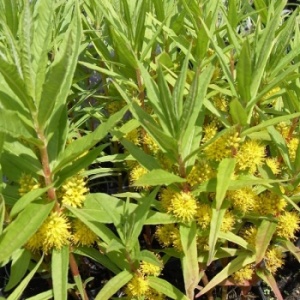

USDA NRCS. Wetland flora: Field office illustrated guide to plant species.
USDA Natural Resources Conservation Service. Provided by NRCS National Wetland Team.
Where Commonly Found: Ditches, bogs, fens, shores of rivers, lakes and wetlands, and swamps.
How to Identify:
(For unfamiliar words: Wikipedia Glossary of Botanical Terms).
Go Botany Key for Lysimachia thyrsiflora.
Illinois Wildflower’s description of Lysimachia thyrsiflora. Click on more images.
Flower Color: Pale yellow to yellow, sometimes dotted with purple.
Flower Type: Radially symmetrical, short, dense racemes, about 1″ -1.5″ long and 1″ across, arising from the middle leaves axils on peduncles about .5″ – 2″ long. Individual flowers are about .3″ across with 5-7 lobes, a pale green to yellow calyx with 5-7 lobes and 5-7 exerted stamens and an exerted style.
Flower Time: Late spring to mid-summer.
Leaf Arrangement: Opposite along a central, unbranched stem that is light green to purplish red, usually glabrous and slightly hairy along the upper half. Plant can look much like purple loosestrife when not in flower, but purple loosestrife has square stems.
Leaf Type: Simple, scale-like leaves at bottom of stem, otherwise pairs of leaves about 2″-6″ long, longer leaves as move up the stem, and .25″-2″ wide, linear-elliptic to elliptic with smooth margins, usually sessile or very short petioles. Upper surface is medium green, glabrous or sparsely hairy.
Height: 1.25′ – 2.5′
Seed Collection: Small, about .15″ seed capsules replace fertile flowers, with a few triangular seeds each that may be realeased to the wind or water. AS THIS PLANT IS RARE OR ENDANGERED IN PARTS OF OUR REGION PLEASE FOLLOW GUIDELINES BY THE CENTER FOR PLANT CONSERVATION.
Attracts: Bees and Moths
Use: Naturalized gardens
Light: Full to part sun
Hardiness Zone: 4-8 USDA Zone Map
Soils: Moist to wet.
Notes:
Native to: RARE AND/OR ENDANGERED IN PARTS OF NH, native in much of the northern half of the US. Biota of North American Program, North American Plant Atlas.
Requested by Bronx River Wildflower Corridor, Roseanne Andrade.
You must be logged in to post a comment.